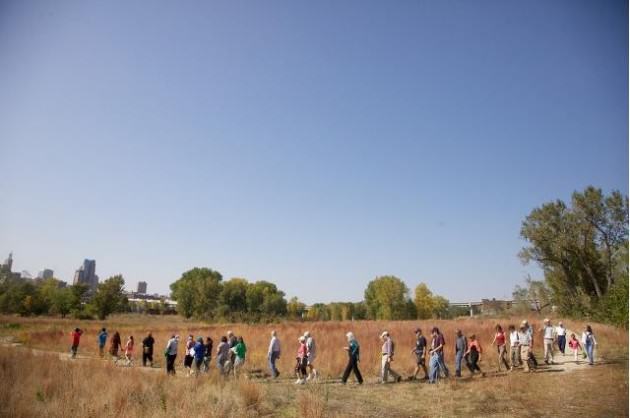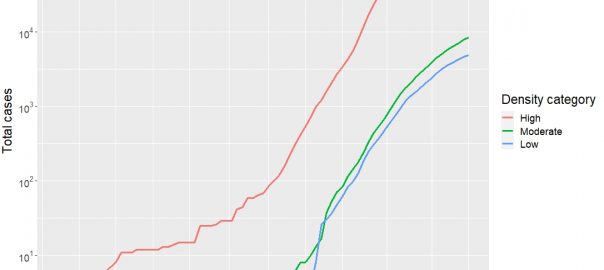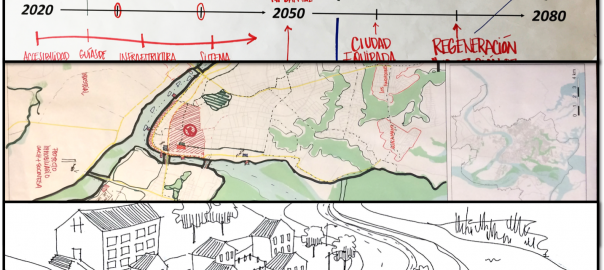With almost all of my career (and most of my adult life) spent working in or around city parks, I was recently surprised to learn an astonishing fact. In American’s largest cities, more than half contain park systems that are more than 50 percent “natural.” In fact, in America’s 10 largest cities, all but one (Chicago) have park systems where more than half are natural.
The idea that our nation’s largest cities are repositories of natural areas of significant size flies in the face of not only the perception of cities as crowded “concrete jungles,” but also of the popular image of city parks all being in the Olmstedian tradition, of designed, heavily manicured greenswards or large modern recreational facilities — ballfields, tennis courts, golf courses, running and cycling tracks, and skating rinks.
That so much of the park systems of our largest cities are natural has profound implications for the future not just of the park systems themselves, but also for the environmental sustainability of cities and for all of the factors that go into planning, designing, constructing, and managing parks. And as cities confront climate change, rising sea levels, increased storm water runoff, or drought, and in some cases burgeoning populations, their parks and especially their natural areas, will play even more important roles, particularly as they are recognized for providing ecosystems services and other benefits.
Importantly, city officials, park managers, scientists, landscape architects, planners, engineers, and open space advocates understand the value of natural areas in cities, and are taking steps to protect, study, manage, and, in some cases, restore natural areas.
These facts can be found in the recently issued 2014 City Park Facts (CPF), written and published by The Trust for Public Land’s Center for City Park Excellence, a “think tank” for urban park issues. For readers wondering how America’s biggest cities — some of them very densely populated and developed — have so much natural land within their borders, it is important to first define the terms. According to CPF, “Natural areas are either pristine or reclaimed lands that are open to the public and left largely undisturbed and managed for their ecological value (i.e., wetlands, forests, deserts). While they may have trails and occasional benches, they are not developed for any recreation activities beyond walking, running, and cycling.”
CPF also takes pains to define “Designed Parkland”: “Designed areas are parklands that have been created, constructed, planted, and managed primarily for human use. They include playgrounds, neighborhood parks, sports fields, plazas, boulevards, municipal golf courses, municipal cemeteries, and all areas served by roadways, parking lots, and service buildings.”
In most cases, the natural areas were deliberately preserved as part of official efforts to save large open spaces and preserve their natural aspects. In other cases, the preservation of natural areas was somewhat accidental at first, as open space acquired to develop as active parkland sat fallow due to lack of resources or civic will, or formerly disturbed areas (garbage dumps, filled-in freshwater and tidal wetlands) were naturalized as human intervention tailed off.

The “benign neglect” theory applies to New York City, by far the nation’s largest city, and the largest city to have a park system more than 50 percent natural. I have some experience with that, as for two years in the late 1980’s, I was the Director of the NYC Parks Department’s Natural Resources Group (NRG). The NRG was created in 1986 under then Parks Commissioner Henry J. Stern. Stern had a personal fondness for natural areas and especially for trees, and his First Deputy Commissioner, Robert Santos, proposed creating the NRG to assess and develop management plans for the City’s natural areas.
This was a watershed moment for NYC, and perhaps for urban park management nationally, because generally speaking, the then quite vast areas of woodland, meadow, and salt and freshwater wetland (approximately 10,000 acres of city parkland; another 7,000 acres of Federal parkland were mostly “natural” as well) were shown on park maps as “undeveloped land.” While recent Federal and State regulations offered some protections for wetlands, the natural areas were all subject to being “developed“ for active recreation purposes, or in some cases for roadways. With the creation of the NRG, we set out to determine what the resource was, see how healthy it was, assess the types of restoration or other intervention that might be appropriate, and also promote the values of the wild areas through education and the creation of trails and nature centers, helping people to understand, appreciate, and use them more.
How did NYC come to possess so much “natural” open space? Some of it was deliberate — though Robert Moses is reviled for filling in wetlands and building major highways along shorelines, he also presided over the saving of what was left of the open spaces of Jamaica Bay, including land that would later be transferred to the National Park Service as part of Gateway National Recreation Area. Much earlier, in the early 1880s, John Mullaly led an effort to acquire and protect as parkland almost 6,000 acres of woodlands and meadows and wetlands in the Bronx, creating Pelham Bay Park — still the city’s largest park and almost four times the size of Central Park — along with Van Cortlandt Park and Bronx Park, later the homes of the Bronx Zoo and NY Botanical Garden.
But other “natural” parks are former dumps, filled-in wetlands, and areas of designed parks that either naturalized due to lack of maintenance, or were deliberately restored or managed as natural areas.
In many other cities, the preponderance of natural areas is due to “the idiosyncrasies of city boundaries” according to the CCPE, but also because many cities have within their boundaries large Federal or State parks or natural areas. In that vein, Anchorage, Alaska leads the pack. Its astonishing 501,785 acres of parkland include just 2,400 acres of designed parks, and the vast majority of its parkland is contained in the Chugach State Park, with 490,125 acres within the Anchorage city limits. Spacious natural parks also dominate in cities with large populations as well as in those not as densely populated.
Of the 36,113 acres of parkland in Los Angeles, more than 26,000 are natural, with the State managing over 10,000 acres, and the Mountains Recreation and Conservation Authority managing almost 6,000 acres. Phoenix, Arizona also has a huge park system, mostly city-owned, and 43,610 acres are natural, with 5,654 acres designed. Of Scottsdale, Arizona’s nearly 29,000 acres of parks, a scant 974 are designed. In New Orleans, Louisiana more than 24,000 of the total 28,432 acres of parks are contained in the Bayou Sauvage National Wildlife Refuge.

So with all of this natural land in many cities, what are the best strategies for protecting and even expanding these areas? Some of them face threats that may include inappropriate development (such as utility rights of way), lack of funding for maintenance and security, and the effects of climate change. Is there consensus among city leaders, or even among environmental managers, for how best to take care of the resource? For example, in many places there have been efforts to restore natural areas through the careful eradication of non-native, exotic species of plants, and even of animals. But that is an expensive proposition, with no certainty of a desired outcome, and some professionals, such as Peter del Tredici, suggest that we should respect the tenacity and success of certain invasives and not try to fight an ultimately losing battle against them.
What are the challenges confronting natural areas in cities and the benefits they provide? How can cities best address these challenges, and who are their potential allies?
First, the impetus to protect and enhance urban natural areas must start locally. In a number of cities, municipal and county government and non-profit organizations have come together in productive partnerships. The Green Seattle Partnership provides a sophisticated stewardship model for urban woodlands. In Portland, the Intertwine brings together a variety of levels of government and the non-profit sector to address the varied needs of natural spaces and the connective tissue of greenways. The Chicago Wilderness Alliance links together public and private entities with a focus on the prairie ecosystem.
But a stronger partnership between the three prominent levels of government may be the key to success in the preservations and productive use of urban natural areas. In New York City, the NRG is partnering with the US Forest Service in the operation of an “Urban Field Station,” a jointly run laboratory where city, state, federal, and academic researchers and practitioners are studying the impact of natural areas and trees on the environmental health of cities. The Million Trees NYC project, that has led to the planting (so far) of nearly 850,000 trees, is now the focus of research projects thorough the Urban Field Station. It is accepted that trees and woodlands play an important role in cleaning the air, storing carbon, mitigating the urban heat island effect, and processing storm water, but how much of a role do they play, relative to other design features? Which trees function best in the difficult urban environment, and what is the mortality rate of small whips planted in old landfills, compared to large balled-and-burlapped trees planted in sidewalk pits?
Part of the funding for the research, and for base level assessments of the natural areas of NYC is coming from a major public-private partnership focused on helping protect and manage the resources, known as the Natural Areas Conservancy, which in just a few years has already raised over $5 million in donations from private funders. Also in New York City, a conservancy has been formed to partner with both the National Park Service and the NYC Parks Department on caring for and programming the 10,000 acres of mostly natural parklands of Jamaica Bay, and a research institute focused on the damaged ecosystem of the bay has recently been created.
But the biggest lift may be the one of changing attitudes. Too many elected officials still look at large natural areas and see them as “empty” or “undeveloped,” envisioning active recreation facilities, roads, container ports, or real estate developments. In coastal cities, at least, drastic weather events such as Hurricanes Katrina and Sandy have shown the perils of building anything in flood zones, but as cities grow and feel the pressure to create housing and economic development, will we forget the cruel lessons of the recent past?
Particularly in cities affected by extreme weather events, we have seen an evolution and new appreciation for the ecosystems services value of natural areas, and even the value of creating green infrastructure to capture storm water and mitigate storm surge, with the attendant layers of value as parks and habitat. And there may be additional, less urgent, but equally interesting challenges.
There are a number of metrics that have been developed for calculating the value of trees on city streets and in landscape designs, but not necessarily for urban forests. Can we develop metrics for the value of large urban natural areas? How much carbon dioxide can be processed by one tree? What are the optimum species and sizes? What is the rate of return of a large wooded area? Does size matter, or is it density and species composition? The groundbreaking work of Richard TT Forman in landscape ecology offers ways to predict the soil’s carbon storage potential in different types of forests or other landscapes, based on such factors as types of plants and rainfall data. Are all wetlands generally helpful in storm surge mitigation, or must they be of a certain magnitude? Can we develop metrics that would suggest an ideal amount of tidal wetland or number of trees per person for an environmentally healthy city?
Three decades ago, forestry school graduates and ecologists were looked at as batty to practice their trades in or focus research on cities — surely, no real “nature” was taking place there. But as people around the world and in the US (83 percent at last count) live in cities, and as we come to understand the extraordinary value of natural areas to cities, the cutting edge research and practice of natural area protection and management will increasingly take place in urban areas. Elected officials, public sector managers, non-profit and academic partners, and citizens can help to effect a sea change in how our urban natural areas are viewed, appreciated, and treated going forward.
Adrian Benepe
New York City







Leave a Reply